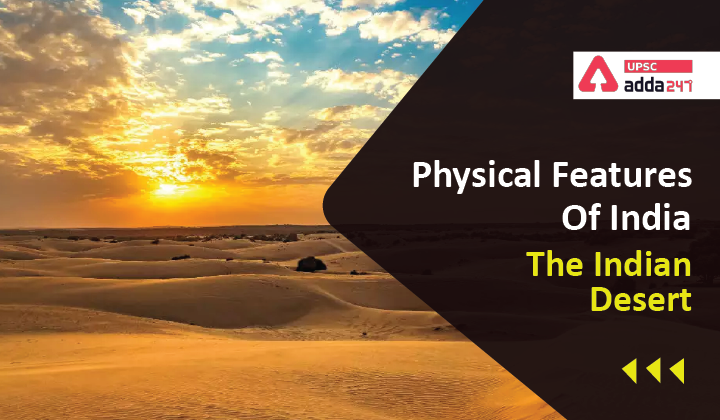Table of Contents
The Indian Desert: Relevance
- GS 1: Distribution of key natural resources across the world
Physical Features of India
- India’s physical features can majorly be divided into 6 parts:
- The Northern and North-eastern Mountains
- The Northern Plain
- The Peninsular Plateau
- The Indian Desert
- The Coastal Plains
- The Islands.
- We have already dealt with Himalayas, Northern Plains, Peninsular Plateau and The Coastal Plains of India comprehensively. In this article, we will discuss about The Indian Desert.
The Indian Desert
- Location: To the northwest of the Aravali hills.
- Orientation: On the basis of the orientation, the desert can be divided into two parts: the northern part is sloping towards Sindh and the southern towards the Rann of Kachchh.
- Features: It is a land of undulating topography dotted with longitudinal dunes and barchans.
- Barchans: Barchans are crescent shape sand dunes that are formed of desert sand. One of the distinctive feature barchans is that it always faces the wind. It is formed when a lot of sand is present in the desert.
Indian Desert: Marusthali
- The Desert region receives low rainfall below 150 mm per year.
- Due to this reason, it has arid climate with low vegetation cover.
- Low precipitation and high evaporation make it a water deficit region.
- It is because of these characteristic features that this region is also known as Marusthali.
Indian Desert: Geological history
- During the Mesozoic era, the Indian desert was under the sea.
- Evidence: Wood fossils park at Aakal and marine deposits around Brahmsar, near Jaisalmer.
- The underlying rock structure of the desert is an extension of the Peninsular plateau, however, due to extreme arid conditions, its surface features have been carved by physical weathering and wind actions.
Indian Desert: Characteristics
- Thar desert: India has about 85% of the Thar Desert while the rest is in Pakistan.
- Fauna in Thar Desert: Blackbuck, Chinkara, Indian Wild Ass, Caracal, Red Fox, Peacock, Wolf, Sand Grouse, Leopard, Asiatic Wild Cat.
- Desert land features: Mushroom rocks, shifting dunes (locally called Dhrians) and oasis (mostly in its southern part).
- Fertility: The presence of dry riverbeds (e.g., Saraswati) indicate that the region was once fertile.
- The Rajasthan Bagar region has a number of short seasonal streams. These streams support agriculture in some fertile patches called Rohi.
- Bagar: The semi-desert area which is west of Aravalis.
- Rivers: Most of the rivers (e.g., Luni) in this region are ephemeral unlike Himalayan rivers that are perennial.
- Luni originates in the Pushkar valley of the Aravalli Range.
- There are some streams which disappear after flowing for some distance and present a typical case of inland drainage by joining a lake or playa. The lakes and the playas have brackish water which is the main source of obtaining salt.
- Thar desert is called world’s wealthiest desert because it is the largest producer of wool in India and in the world. Moreover, minerals like gypsum and kaolin are also found in this region.
Also Read:
| Horticulture In India: Horticulture Cluster Development Programme | Migrant Labour Crisis: Supreme Court Guidelines, Issues And Solutions | Legislative Council: A Complete Analysis | Unlawful Activities (Prevention) Act (UAPA), 1967 |
| Financial Stability Report | Freight Smart Cities: Logistics Issues and Government Steps | Fishery Subsidy And The Issues Arising From It | Understanding the India- Afghanistan Conundrum |
| The History of Backward Classes Commission And the Sub-Categorisation of OBCs | Elderly Population Of India: Expert Committee On Longevity Finance | Impact of US Inflation in India | Pradhan Mantri Awas Yojana- Gramin |



 TSPSC Group 1 Question Paper 2024, Downl...
TSPSC Group 1 Question Paper 2024, Downl...
 TSPSC Group 1 Answer key 2024 Out, Downl...
TSPSC Group 1 Answer key 2024 Out, Downl...
 UPSC Prelims 2024 Question Paper, Downlo...
UPSC Prelims 2024 Question Paper, Downlo...





